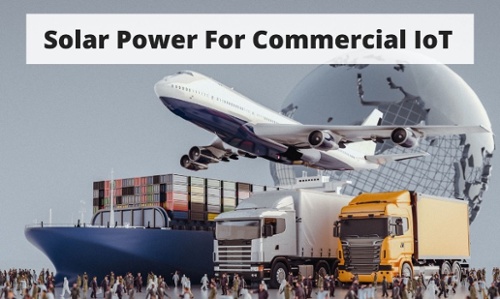
As the IoT industry rapidly expands into commercial, consumer, and industrial spaces, new and innovative ways to power the increasing number of connected devices are needed to ensure sustainability, feasibility, and environmental responsibility.
Often unconventional energy sources are hiding in plain sight. Vibrations in vehicles from the road and engine, radio signals from cell towers and WiFi routers, even body heat from your skin can provide enough energy to run low power electronics. Whether indoors or outdoors, light is an abundant energy source that can be used to power a wide variety of applications, large and small.
For this IoT series, we will look at the different IoT market spaces, identify power needs for applications in that space, and define what a solar harvesting solution looks like.
In the commercial world, IoT is all about economics.
Internet of Things enables businesses to cut costs, operate more efficiently, and expand their capabilities. The backbone of commercial IoT solutions is data. “The cloud,” data analytics, and machine learning crunch enormous amounts of data and spit out answers that humans may not be able to come up with.
But where does all this data come from?
In an automated building, extensive networks of sensors collect and send data to a central location, which can then efficiently control heating/cooling systems, lighting, security systems, and take advantage of data analytics tools. Large buildings may have thousands of sensors measuring temperature, occupancy, pressure, humidity, light level, air quality, and other points.
These sensors typically use ultra low power wireless communication to send and receive data. Bluetooth low energy (BLE) has a good balance between low power consumption (as low as 10uW) and high performance. BLE has an effective line of site range up to 300 ft but is usually shorter in an indoor setting. Low Power Wide Area Networks (LPWAN) such as LoRaWan have much larger ranges, enough to cover an entire office building or facility. LPWAN networks can also be very low power but suffer from a lower performance.
Conventionally these devices are powered with small coin cell batteries and have lifetimes ranging from months to years. Designing battery-powered wireless sensors that last longer than a couple of years can be challenging and expensive.
Replacing dead batteries can be very costly in automated buildings with thousands of sensors and controllers. Battery lifetime can’t always be predicted, which lowers the reliability and effectiveness of the system as a whole.
Energy harvesting and specifically solar/light harvesting can completely replace batteries in many of these applications. In Indoor settings, PowerFilm low light solar panels experience little to no degradation and can last 20+ years. Almost no maintenance means more cost savings and a better return on investment for businesses who take advantage of building automation.
The locations where sensors are placed are often in work areas, walkways, or common areas, in which the lights are on for a majority of the workday. The indoor light can be collected using PowerFilm indoor/low-light solar panels. Let's look at a real-life example to get a better idea of how to use solar to power wireless sensors
First, find a sensor that is compatible with your system. A Monnit Wireless Temperature Sensor measures ambient temperature and is compatible with MODBUS building automation systems.
Next, determine the sensor’s average daily power consumption and how much solar is needed to power it. The easiest way to determine average power consumption is to look at how long its current batteries last. Manufacturers often list battery information and battery lifetime under the device specifications.
The Monnit Wireless Temperature Sensor operates on a CR2032 3V lithium coin cell battery, which will last about two years. CR2032 lithium batteries have around 200mAh of battery capacity. Always convert units to power (Watt-hours) to avoid voltage mismatch problems.
200mAh * 3V = 600mWh
Divide total battery capacity by the battery lifetime to get average daily power consumption.
600mWh / (365 days * 2)
Next, get solar power needed by dividing daily consumption by the number of hours of light expected per day. If we assume that lights are on for an average of 8 hours per day:
.882mWh per day / 8h per day
The light level of dimly lit rooms and warehouses is usually around 200 lux. We will use this as a worst-case scenario to size the solar panel.
PowerFilm Low Light series solar panels will generate 0.005mW/cm^2 at 200 lux. Divide power needed by power density to get the total area required. As a general rule, add 20% to account for lighting uncertainty and charging losses.
0.103mW/.005*1.2 = 30cm2
A custom-sized 3V PowerFilm low-light panel this size would fit directly on the sensor’s enclosure. In brighter lit environments or near windows, an even smaller panel could be used.
The last step is to choose energy harvesting and power management hardware. Texas Instruments BQ25570 is an ultra-low-power energy harvester IC that can also manage battery charging and features a regulated output power rail.
We will configure the BQ25570 to charge a 40mAh rechargeable Li-Polymer battery and set the output voltage to 3V. This exact configuration is implemented in the Solar Development Kit (DEV-BASIC). It can be used directly as a plug and play solution with any of PowerFilm’s low-light series solar panels.
There are many energy harvesting and power management hardware options available which can be tailored to minimize cost, maximize performance, reduce physical footprint, and optimize systems.
Solar harvesting is a versatile technology enabling battery and maintenance free commercial IoT systems.
What systems or applications could you power with solar?
PowerFilm can work with you to find the best solar solution for your application.
Want to learn more? Contact us, and let’s get started today.